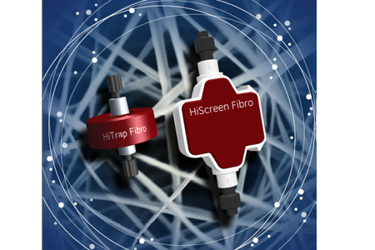Automated High Throughput mAb Purification Using Fibro Technology

The need for higher throughput and more efficient process development
Biomanufacturing is trending towards higher numbers of monoclonal antibody (mAb) projects and smaller batch sizes, with production of most mAbs below 100 kg/yr (1). These trends are fueling demands to screen more clones faster and improve the efficiency of process development (PD). Current approaches to purify mAbs for high-throughput screening of lead candidates and optimization of process conditions often uses resin-based columns and liquid handling robots. This setup requires a large footprint and capital-intensive equipment. Fiber-based chromatography (Fibro) has an open pore structure where mass transfer is governed by convective flow rather than diffusional flow as for resin-based chromatography (2). The Fibro technology with immobilized protein A ligand allows high mAb binding capacities at very short residence times, which results in cycle times of minutes instead of the hours needed for resin-based chromatography. The rapid cycling using Fibro PrismA units offers new opportunities in high-throughput purification for screening of lead candidates and process conditions.
This study evaluated performance of Fibro units coupled with alkali-stable protein A ligand, HiTrap Fibro PrismA, in automated one- and two-step purification on an ÄKTA pure chromatography system with attached autosampler. Performance was compared with that of a HiTrap MabSelect PrismA column. For the two-step protocol, eluate from the capture step was automatically loaded onto two 5 mL HiTrap Desalting columns connected in series to obtain buffer exchange for subsequent analytic characterization, as illustrated in Figure 1. Recovery and total purification time were evaluated, as were critical product quality attributes (PQAs) including charge variants, aggregate and fragment content, peptide mapping, and N-glycosylation analysis. Peptide mapping and N-glycosylation analysis were performed using MAM-MS. Total run time was substantially lower for the HiTrap Fibro PrismA unit, while recovery and evaluated PQAs were comparable across both technologies.
Get unlimited access to:
Enter your credentials below to log in. Not yet a member of Bioprocess Online? Subscribe today.
